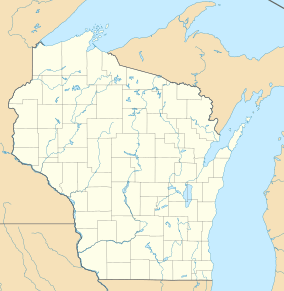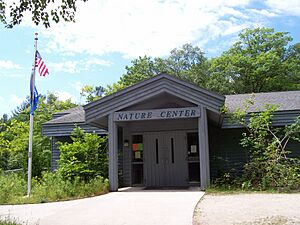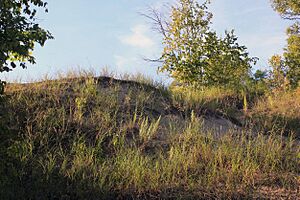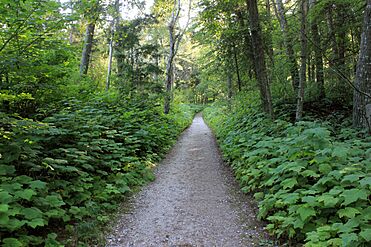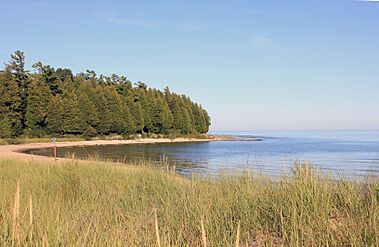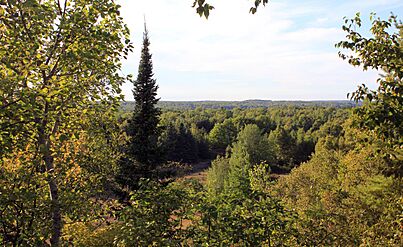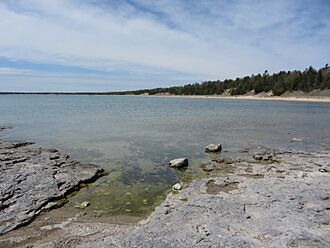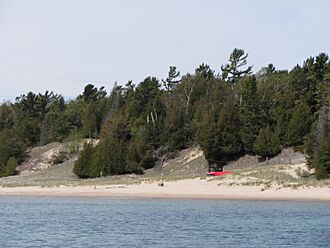Whitefish Dunes State Park facts for kids
Quick facts for kids Whitefish Dunes State Park |
|
|---|---|
|
IUCN Category III (Natural Monument)
|
|
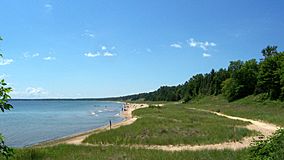
A Lake Michigan beach in Whitefish Dunes State Park
|
|
| Location | Door, Wisconsin, United States |
| Area | 867 acres (351 ha) |
| Established | 1967 |
| Governing body | Wisconsin Department of Natural Resources |
| Website | Whitefish Dunes State Park |
Whitefish Dunes State Park is a beautiful state park in Wisconsin. It covers about 867 acres. You can find it on the eastern side of the Door Peninsula. This park is special because it protects the biggest sand dunes along the western shore of Lake Michigan. These dunes are like giant sand hills!
Long ago, Native American villages were here. We can still find signs of eight different villages from a very long time ago. This area is so important that it's listed on the National Register of Historic Places. Right next to the park is Cave Point County Park. You can walk from Cave Point into Whitefish Dunes State Park along the shoreline trail.
Contents
History of Whitefish Dunes State Park
People have lived in the Whitefish Dunes area for a very long time. We have found proof of early settlers from 100 B.C. all the way to the late 1800s.
Early Native American Settlements
- Around 100 B.C. to A.D. 300, the North Bay people lived here. They left behind pieces of pottery in the sand dunes.
- After them, the Heins Creek people, who were their descendants, lived in the same area.
- Later, during the Late Woodland period (A.D. 500–1000), two more groups settled here. One group lived here from A.D. 800-900.
- Then, the Oneota people arrived around A.D. 900.
Fishing Camps and Trade
In the early 1800s, people started setting up fishing camps in the area. One of these camps was started by James Pearson Clark from New England. At this time, trade by boat also began to grow on the lake.
Fun Activities at Whitefish Dunes
Whitefish Dunes State Park is a great place for many outdoor activities. You can go hiking on the trails, try fishing, or enjoy canoeing and boating on the water. Swimming is also a popular activity on the beach.
Picnic Areas and Winter Fun
The park has many picnic tables where you can enjoy a meal outdoors. There are also shelters you can rent for bigger groups. When winter arrives, the park transforms! You can go cross-country skiing and snowshoeing on the snowy trails.
Nature Center and Learning Programs
The Whitefish Dunes Nature Center is a cool place to visit. It has exhibits that teach you about the park's plants, animals, rocks, and its history. The center is open all year round. They offer special programs for both kids and adults. These programs help you learn more about the park's natural and cultural history. Park naturalists are also there to answer your questions and give tours.
Exploring Park Trails
The park has many different trails for hiking.
- The Black trail is about 2.5 miles long. It goes through the woods and has some rocky areas.
- The Brachipod trail is about 1.5 miles long. On this trail, you might see fossils and enjoy beautiful nature views.
- The Clark Lake Spur trail is shorter, about 0.7 miles long.
- The Green trail is about 1.8 miles long.
- There are also other trails like the Red, Red Pine, Whitefish Creek Spur, and Yellow trails.
Nature and Wildlife
Whitefish Dunes State Park is home to many different animals. You might spot rabbits, raccoons, skunks, squirrels, and woodchucks. The dunes also have reptiles and amphibians like frogs, painted turtles, salamanders, and snakes.
Rare Plants in the Natural Area
Inside the state park, there's a special area called the Whitefish Dunes State Natural Area. This part covers about 230 acres. It protects rare types of plants. Two examples are the prairie sand-reed grass and the dune thistle. These plants are important to protect because they are not found in many other places.
How Dunes Change: Erosion and Building
Sand dunes are always changing. When fine sand is exposed to the wind, the wind starts to move it. The tallest dunes in the park are held in place by plants. These plants help stop the sand from blowing away.
Active Dunes and Shoreline Erosion
There are also areas with "active dunes." These dunes are smaller and are still growing and moving. They probably won't get as tall as the older, plant-covered dunes.
Water also changes the shoreline. When the lake levels are very high, especially during an 11-year cycle, the water can cause a lot of erosion. Strong waves during storms can make this erosion even worse. During these times, huge amounts of sand are washed away from the shoreline and the dunes.
Dune Building Process
But when the lake water goes down, more beach is uncovered. This exposes the fine sand particles to the wind again. Then, the process of dune-building starts all over! The wind picks up the sand and piles it up, creating new dunes.
Geology of the Dunes
The dunes at Whitefish Dunes State Park have a fascinating geological history. Scientists have found several fossils in the sand. These fossils came from sediment that was once at the bottom of the water.
Fossils and Formation
You can still see fossil sea shells and even parts of ancient coral reefs at the dunes today. The wind and water are always working to change and reshape the dunes. The wind pushes the sand until it drops and forms a pile, which we call a sand dune.
Plants That Survive in Sand
Not many plants can grow well in sand dunes because of the wind and shifting sand. However, a special plant called marram grass is very tough. It can survive the strong winds and changing water levels of the dunes. The park also includes an esker, which is a long, winding ridge of sand and gravel left behind by glaciers.
Climate
|
||||||||||||||||||||||||||||||||||||||||||||||||||||||||||||||||||||||||||||||||||||||||||||||||
Gallery


